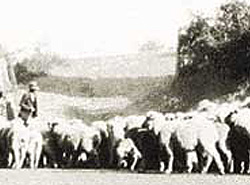In
1940 a fossil human skull was uncovered by James White as
he worked with a pick in the Hughes Soil Pit, a small quarry
where Dry Creek meets the Maribyrnong River in Keilor.
The
skull was found in the yellowish silt of an ancient terrace,
with the mandible and a part of each zygomatic arch of the
right temporal bone and part of the occipital bone missing.
James White’s pick had penetrated the skull of a middle-aged
aborigine now known as the Keilor Skull, but more accurately
called the Keilor Cranium as no mandible was associated
with it. The skull was placed in the National Museum,
Melbourne. It appears that the cranium had been worn by
the river before being interred in its resting place in
the quarry - about 15 feet below the surface of the ground
and 18 inches above the floor of the pit.
Radiocarbon dating of charcoal taken from hearths at the
Dry Creek site suggest that there was Aboriginal occupation
in the area as long as 40,000 years ago. Keilor is one of
the oldest sites of recorded human habitation in Australia…Some
of the fauna which inhabited the Maribyrnong River Valley
around Keilor during the latter stages of the Ice Age.
Diprotodon - measuring 2 metres high and 3 metres in
length, it is believed to be the largest marsupial ever
to have lived.
Thylacoleo - also known as the marsupial lion. This
animal, the size of a leopard had three pairs of upper incisors
which formed a powerful set of large pincers. There has
been much conjecture as to whether this animal was carnivorous
or herbivorous. Its premolar teeth being 4-5 cm. Long. This
animal is similar to the Common Brushtail Possum.
Palorchestes Azael - In 1988 the jawbone of a palorchestes
azael, an animal the size of a bull was found during trench
excavations at Horseshoe Bend in Keilor. The animals massive
forelegs were equipped with 12 cm. Long razor sharp claws
whilst its strange head was equipped with a trunk.
Procoptodon - also known as the short-faced kangaroo,
these animals had forward-pointing eyes, shortened faces
and heavily enamelled molars. Their hindlegs were very unusual
with the elongated feet possessing a single large toe, which
ended in a hoof-like nail. These animals and many
others, such as rats, wallabies, bandicoots, freshwater
shellfish, possums, echidnas, swans, bush turkeys, along
with different plants, including the daisy yam, provided
a rich harvest for the Aboriginal people who lived in the
area.
Keilor has evolved, in respect to European history, over
four distinct stages:- Pastoral acquisition 1835
- 1850, Gold Rush Period - 1850s, Market
Garden Developments - 1860s - 1950s and then Suburbanisation
from the 1950s onwards. |
|
